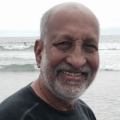Taliban fight for freedom, justice
By Mustafa Malik
SYLHET, Bangladesh — Aunt Salima Khatun, my mother’s sister, barged in to see me here in the Bangladeshi town of Sylhet. I spend part of my Bangladesh vacations in Sylhet, known for its tea gardens, cane furniture and the shrine of the famed Muslim saint Hazrat Shah Jalal.
Behind Aunt Salima was her grandson, a college student, carrying a big bowl. It had several dozen homemade sweets, wrapped in banana leaves under plastic covering. They were made of flour, meshed with the delicious juice of a local fruit known as “tal” and other ingredients, before being rolled into round cakes and cooked.
“When you were a little boy, you loved ‘tal sandesh’ (tal sweets),” said my aunt, 81. “See if you like them.”
As the conversation progressed, she asked if I could bring the student over to the United States for further education. He had been “pulling out my hair,” meaning badgering her, to make me the request, she added. I apologized for my inability to help him get a U.S. visa.
The young man was, however, a member of an Islamic student group, which campaigns against U.S. and Israeli occupation of Muslim lands. Why was President Obama “so viciously opposed” to Palestinians’ U.N. membership? he asked. He was elated, however, that Muslim guerrillas were “throwing out the [Western] invaders” from Iraq and Afghanistan. Would Americans “dare to occupy a Muslim country again?”
His admiration for anti-American guerrillas is widely shared by most Muslims in South Asia, as I have learned during trips through the region. Noor M. Khan, a family friend in the northeast Indian town of Haflong, told me during a visit there last year that “our mujahedeen [Islamic guerrillas] are our only hope against American imperialism.” The Afghan mujahedeen drove back Russian invaders from Afghanistan in the 1980s, he continued. Now thanks to the Taliban, American occupation forces would be fleeing Afghanistan, “peeing in their pants.”
Many South Asian Muslims, as many Muslims elsewhere, usually get to like Americans with whom they come in contact. Many try to migrate to the United States for a better life. If young, some of aspire to have an American education, as my aunt’s grandson does. Yet the same Muslims would be denouncing Americans vehemently for America’s “war on Islam.”
It’s a déjà vu of the last decades (1910s-1940s) of British colonial rule in what was then “British India.” Those days many Indians had British friends. Many were educated in British schools or British-style secular schools in India. Yet some of them joined the struggle to liberate their country from British colonialism. British-sponsored education had taught them Western concepts of liberty and freedom and inspired them into anti-colonial struggle.
Justice is Islam’s core principle. Muslims, secular or religious, innately resist foreign hegemony because they consider it fundamentally unjust. Today most of the leaders and many activists of Muslim movements against U.S. invasions and domination zest for freedom among Muslims, firing them up against American hegemony. In earlier times, onset of modernity stoked their struggles for freedom against European colonialism..
Modernity, it seems, has become the West’s Frankenstein’s monster!
But many of South Asia’s anti-American Muslim guerrillas are educated in madrassahs, or Islamic schools. They’re inspired by their innate antipathy for foreign military presence — which they share with many secularist activists — and pride in Islamic civilization, which madrassahs have inculcated in them. In October 2007 a madrassah-educated Taliban supporter in Pakistan’s Mohmand tribal agency town of Ghalanai (whose name I promised not to publish) said to me that Muslims had built “the glorious Spanish civilization and taught Europeans the sciences and philosophy for more than 700 years.” How many years, he asked, could “American Crusaders” stick around in Afghanistan?
The Taliban and other Pakistani and Afghan militants with only a madrassah education are also fighting for freedom from foreign occupation and domination. Most of them just don’t know that freedom is a core American value that Americans once fought wrest from British colonialists.
Muslims youths are struggling to snatch that American ideal from the jaws of the American hegemon, which they consider unjust.
● Mustafa Malik is the host of the blog site Beyond Freedom.
